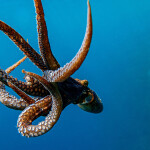The global production of farmed shrimp is poised to double in the next decade from 4 million metric tons (MT) to 8 million MT, thanks to layers of sophisticated disease controls employed by the industry.
That was the prediction of George Chamberlain, president of the Global Aquaculture Alliance (GAA), the keynote speaker at the organization’s GOAL 2014 conference on Wednesday in Ho Chi Minh City, Vietnam. He tempered his optimism with a sobering report on the challenges the industry faces in controlling diseases that can rapidly spread across large production areas.
“The journey to control disease will never end,” said Chamberlain, but improved surveillance, genetic resistance, breeding techniques, biosecurity measures and innovative feed additives to combat diseases like Early Mortality Syndrome (EMS) are starting to bear positive results.
Global production of all farmed seafood declined by 4 percent overall in 2013 due to the persistent shrimp disease, according to Chamberlain. While the “epidemic” of EMS has been identified, there is no “silver bullet” solution, he added. Employing improved biosecurity measures, however, was a recurring theme from many of the presenters and with the fragmented nature of the aquaculture industry worldwide, it will likely continue to be.
New diseases are continually cropping up, Chamberlain said, including a microsporidian host parasite that affects the shrimp’s pancreas and another called covert nodavirus in China.
In an informal poll of conference attendees, 43 percent said disease control was the most important challenge impacting the growth of farmed shrimp worldwide; Chamberlain said it was the fifth straight year that GOAL attendees identified disease management as the No. 1 challenge.
“We need to revolutionize our biosecurity systems to overcome these problems,” said Tim Flegel, advisor to Thailand’s National Center for Genetic Engineering and Biotechnology, during a disease risk management panel.
Zone management is a control method that is gaining ground, said Peter Marshall, founding director of RS Standards and chair of GAA’s Zone Management Technical Committee. Collaborative efforts are at the core of effective zone management. “When ‘I’ is replaced with ‘we,’ illness becomes wellness,” said Marshall.
Also, during the disease-control panel discussion, Loc Tran, Minh Phu Aquamekong ShrimpVet Lab at Nong Lam University in Vietnam, was recognized for identifying EMS and his current work on tilapia production.
EMS has had a huge impact on the conference’s host country, Vietnam, where seafood production has a major impact on the nation’s economy. Dr. Pham Anh Tuan of Vietnam’s ministry of agriculture and rural development, and the Directorate of Fisheries (D-FISH), informed conference attendees that aquaculture is responsible for 3.21 million metric tons of seafood, compared to 2.71 million metric tons of wild-capture product in 2013. Fisheries in Vietnam are responsible for 40 percent of all national food production and 4 percent of the country’s GDP, employing 4 million workers. “It’s growing considerably, thanks to pangasius and other freshwater fish,” said Dr. Tuan.





